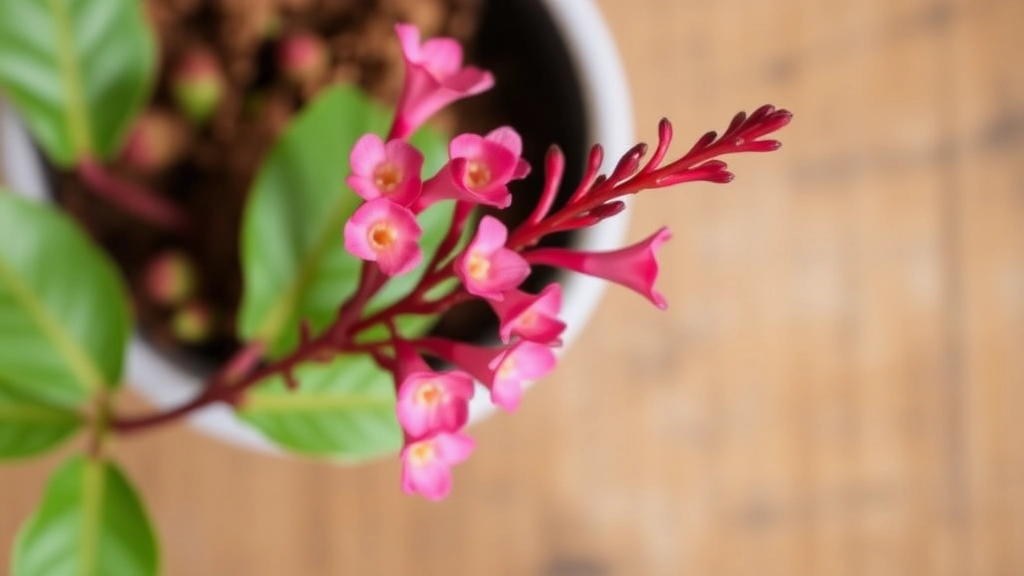Kalanchoe: A Medicinal Plant
Is Kalanchoe a medicinal plant? Absolutely! This versatile plant has been used in traditional medicine for generations. Known for its anti-inflammatory and wound-healing properties, Kalanchoe is a go-to remedy for skin conditions and minor injuries. But its benefits don’t stop there; it’s also known to help with respiratory issues and gastrointestinal problems.
In recent studies, Kalanchoe has shown promising results in cancer treatment, pain relief, and even oral health. Whether you’re dealing with a headache, back pain, or looking for a natural way to treat infections and fevers, Kalanchoe might just be the answer. However, it’s essential to be aware of potential side effects and use it safely. Let’s dive deeper into the medicinal wonders of this remarkable plant.
Have you ever wondered about the natural remedies that can enhance your well-being? Kalanchoe, a succulent plant, has been making waves in the world of herbal medicine for its diverse medicinal uses.
This remarkable plant has been traditionally used for various ailments, and its popularity continues to grow in modern herbal practices.
### Key Medicinal Uses of Kalanchoe
– **Anti-Inflammatory Properties:** Kalanchoe is renowned for its anti-inflammatory effects. This makes it beneficial for conditions like arthritis or general inflammation.
– **Wound Healing:** The plant contains compounds that promote faster healing of cuts and bruises, making it a go-to remedy for minor injuries.
– **Skin Care:** Kalanchoe is often included in skincare products due to its soothing properties. It can help alleviate skin irritations and enhance overall skin health.
– **Respiratory Health:** Many people use Kalanchoe to ease respiratory issues. Its expectorant properties can help clear mucus and ease breathing difficulties.
– **Gastrointestinal Aid:** The plant has been noted for its ability to help treat ulcers and other gastrointestinal problems, providing relief from discomfort.
– **Cancer Research:** Emerging studies suggest that Kalanchoe may have potential benefits in cancer treatment, although more research is needed in this area.
– **Pain Relief:** From headaches to back pain, Kalanchoe is believed to offer natural pain relief, making it a versatile option for those seeking alternatives to over-the-counter medications.
– **Oral Health:** Kalanchoe can also be beneficial for oral health, helping to soothe gum inflammation and promote healing in the mouth.
– **Infection and Fever Treatment:** Its antimicrobial properties make Kalanchoe a useful remedy for treating infections and managing fever.
– **Muscle Relaxation:** Kalanchoe is noted for its muscle-relaxing properties, which can be particularly helpful after strenuous physical activity.
– **Sunburn Relief:** After a day in the sun, Kalanchoe can aid in soothing sunburn and promoting skin regeneration.
For more information on how to use Kalanchoe for health benefits, check out our [guide on Kalanchoe Pinnata](https://planthq.org/kalanchoe-pinnata-tea-benefits-health-and-wellness-guide/). If you’re interested in growing this versatile plant, our [ultimate guide to growing Kalanchoe](https://planthq.org/ultimate-guide-to-growing-kalanchoe-pink-plant/) can help you get started.
Anti-Inflammatory and Wound-Healing Properties

Have you ever dealt with pesky inflammation or slow-healing wounds? It can be frustrating, right? Well, Kalanchoe might just be the answer you’re looking for.
Kalanchoe is not just a pretty plant; it’s packed with properties that can help reduce inflammation and promote healing.
Anti-Inflammatory Benefits:
- Natural Relief: The compounds in Kalanchoe can help soothe inflammation, making it a go-to for conditions like arthritis or skin irritations.
- Quick Action: Many people have found that applying Kalanchoe extracts directly to inflamed areas can provide almost immediate relief.
Wound-Healing Wonders:
- Speedy Recovery: Studies suggest that Kalanchoe can speed up the healing process of cuts and abrasions.
- Antibacterial Properties: Its natural antibacterial qualities help prevent infections, ensuring your wounds heal cleanly.
Imagine slathering a bit of Kalanchoe gel on a scraped knee or a stubborn rash. It’s like nature’s little first-aid kit!
How to Use:
- Topical Application: You can crush the leaves and apply the juice directly to the affected area.
- Infusions: Making a tea or infusion from Kalanchoe can also support healing from the inside out.
When it comes to skin care, many of us are on the lookout for natural remedies that can address a variety of concerns.
Kalanchoe, often referred to as the “miracle plant,” has gained attention for its remarkable properties in skin care treatments.
### Key Benefits of Kalanchoe for Skin
– **Hydration**: Kalanchoe is known for its ability to retain moisture, making it an excellent choice for dry skin.
– **Anti-Aging**: Rich in antioxidants, Kalanchoe helps combat free radicals, which can lead to premature aging.
– **Healing Properties**: Its anti-inflammatory and wound-healing qualities make it effective for treating minor cuts and abrasions.
– **Acne Treatment**: Kalanchoe can help reduce acne due to its antibacterial properties, making it a natural alternative to harsh chemicals.
– **Skin Regeneration**: The plant promotes cell turnover, aiding in the regeneration of damaged skin.
### How to Incorporate Kalanchoe into Your Skin Care Routine
– **Topical Application**: You can apply fresh Kalanchoe juice directly to the skin for immediate benefits.
– **Face Masks**: Combine Kalanchoe with other natural ingredients like honey or yogurt for a soothing face mask.
– **Creams and Ointments**: Look for products that contain Kalanchoe extract for everyday use.
### Personal Experience
I remember trying a Kalanchoe-infused cream during a particularly dry winter. The difference was noticeable; my skin felt hydrated and looked healthier almost immediately.
By integrating Kalanchoe into your skin care regimen, you may find a natural solution to common skin issues. For more information on the benefits of Kalanchoe, you can explore [the health and beauty benefits of Kalanchoe Mother of Thousands](https://planthq.org/discover-the-health-and-beauty-benefits-of-kalanchoe-mother-of-thousands/) or learn about [Kalanchoe Blossfeldiana’s medicinal and decorative uses](https://planthq.org/kalanchoe-blossfeldiana-medicinal-and-decorative-uses/).
Potential Benefits in Treating Respiratory Issues

When it comes to respiratory health, many of us find ourselves searching for natural, effective remedies.
Kalanchoe, often overlooked, may hold promise in alleviating various respiratory ailments.
Key Benefits of Kalanchoe for Respiratory Health
- Expectorant Properties: Kalanchoe can help loosen mucus, making it easier to expel. This can be particularly beneficial for those suffering from bronchitis or chronic coughs.
- Anti-Inflammatory Effects: The anti-inflammatory compounds in Kalanchoe may reduce irritation in the airways, providing relief for conditions like asthma.
- Antimicrobial Activity: Some studies suggest Kalanchoe possesses antimicrobial properties, which can help combat respiratory infections.
- Immune Support: Regular consumption of Kalanchoe may bolster the immune system, making it more resilient against respiratory illnesses.
Practical Applications
- Tea Preparation: Brewing Kalanchoe leaves into a tea can provide soothing relief for sore throats and coughs.
- Inhalation: Infusing Kalanchoe in hot water and inhaling the steam can help clear nasal passages.
Personal Experience
I’ve found that incorporating Kalanchoe into my wellness routine has helped with seasonal allergies, providing a gentle, natural alternative to over-the-counter medications.
When discussing the myriad benefits of Kalanchoe, its potential in addressing ulcers and gastrointestinal issues stands out. Many individuals suffer from conditions like gastric ulcers, acid reflux, and irritable bowel syndrome (IBS). Could Kalanchoe be a natural ally in their journey to wellness?
Ulcers can cause significant discomfort and disrupt daily life. They often manifest as:
– **Gastric ulcers**: Open sores in the stomach lining.
– **Duodenal ulcers**: Occurring in the upper part of the small intestine.
– **Gastroesophageal reflux disease (GERD)**: A chronic condition where stomach acid flows back into the oesophagus.
Kalanchoe has been traditionally used in various cultures to soothe these ailments. Its leaves contain compounds that may help in healing and protecting the gastrointestinal tract.
Research suggests that Kalanchoe possesses properties that can benefit those with ulcers and other gastrointestinal problems:
– **Anti-inflammatory properties**: Reducing inflammation in the gut can alleviate pain and discomfort.
– **Antioxidant effects**: Protecting cells from damage and promoting healing.
– **Mucilage content**: A gel-like substance that can coat the stomach lining, providing a protective barrier against acid.
Here’s how you might incorporate Kalanchoe into your routine:
– **Kalanchoe tea**: Brew the leaves in hot water to create a soothing drink.
– **Topical applications**: Use fresh Kalanchoe gel on affected areas to promote healing.
Many individuals have shared their positive experiences with Kalanchoe. For instance, a friend of mine found relief from her acid reflux after incorporating Kalanchoe tea into her daily routine. She noticed a significant reduction in symptoms, allowing her to enjoy meals without discomfort.
For more detailed information on how to propagate Kalanchoe, check out this [step-by-step guide on Kalanchoe propagation](https://planthq.org/stepbystep-guide-kalanchoe-propagation-from-leaves/). If you’re interested in the different varieties and their care, you might find the [complete care guide for Kalanchoe Pink Butterflies](https://planthq.org/complete-care-guide-for-kalanchoe-pink-butterflies-succulent/) particularly useful.
Cancer Treatment and Kalanchoe: Promising Studies

Have you ever wondered if natural remedies could play a role in serious health issues like cancer?
Kalanchoe, a plant often found in our homes, has been catching the eye of researchers for its potential benefits in cancer treatment.
What’s the Buzz?
Several studies suggest that Kalanchoe may have anti-cancer properties. Here’s what you need to know:
- Active Compounds: Kalanchoe contains flavonoids and other compounds that might help inhibit cancer cell growth.
- Cell Studies: Some lab studies have shown that extracts from Kalanchoe can reduce the viability of certain cancer cells.
- Immune Boost: It’s believed that Kalanchoe can enhance immune response, which could be crucial for those fighting cancer.
Real Stories
I’ve heard from folks who’ve incorporated Kalanchoe into their wellness routines. They often mention feeling more empowered in their health journey.
One friend shared how she used Kalanchoe alongside her conventional treatment and felt it helped with her overall well-being.
What’s Next?
While these findings are promising, it’s crucial to remember that more research is needed.
Always consult with a healthcare professional before adding anything new to your treatment plan.
Pain Relief: From Headaches to Back Pain
Many of us experience pain in various forms, whether it’s a nagging headache or persistent back discomfort.
Kalanchoe has emerged as a natural remedy that may provide relief for these common issues.
Understanding Kalanchoe for Pain Relief
Kalanchoe contains compounds that have been studied for their analgesic (pain-relieving) properties.
Here’s how it can help:
- Headaches: The anti-inflammatory properties of Kalanchoe may reduce the swelling in blood vessels, potentially easing headache pain.
- Back Pain: Many users have reported that topical applications of Kalanchoe extract can soothe muscle tension and discomfort in the back.
- Joint Pain: Its anti-inflammatory effects may also benefit those suffering from arthritis or joint-related pain.
How to Use Kalanchoe for Pain Relief
- Topical Application: Applying Kalanchoe gel or juice directly to the affected area can provide immediate relief.
- Infusions: Drinking Kalanchoe tea may help alleviate pain from within, particularly for headaches.
- Capsules: For those who prefer a more concentrated form, Kalanchoe capsules are available as a supplement.
Real-Life Experiences
Many individuals have shared their success stories, noting significant reductions in pain levels after incorporating Kalanchoe into their routines.
For instance, someone suffering from chronic back pain reported noticeable relief after using a Kalanchoe-infused oil.
This natural remedy is becoming a go-to for those seeking alternatives to over-the-counter pain medications.
Caution and Considerations
While Kalanchoe shows promise for pain relief, it’s essential to consult with a healthcare professional before starting any new treatment.
This ensures that it’s safe and suitable for your specific condition. Additionally, you might want to read about the natural remedy for kidney stones using Kalanchoe Pinnata or explore the various side effects and safety precautions associated with Kalanchoe Pinnata.
Kalanchoe’s Benefits for Oral Health

Have you ever wondered if there’s a natural way to boost your oral health?
Kalanchoe might just be the answer you’re looking for.
This incredible plant isn’t just a pretty face; it has some impressive benefits for your mouth and gums.
Natural Antimicrobial Properties
One of the standout features of Kalanchoe is its antimicrobial properties.
This means it can help fight off harmful bacteria in your mouth.
Here’s how it can benefit you:
- Reduces plaque build-up: By keeping those pesky bacteria at bay, Kalanchoe can help prevent plaque.
- Freshens breath: Say goodbye to bad breath with its natural ability to combat odour-causing germs.
- Soothes gum inflammation: If your gums are feeling a bit tender, Kalanchoe can help calm that irritation.
Healing Wounds and Sores
Ever had a painful mouth sore or cut?
Kalanchoe can lend a helping hand here too.
Its wound-healing properties make it a great natural remedy for:
- Aphthous ulcers: Those annoying little sores can heal faster with Kalanchoe.
- Cuts and abrasions: Applying Kalanchoe juice can speed up the healing process.
Strengthening Teeth and Gums
Want to keep your teeth and gums in top shape?
Kalanchoe’s rich nutrient profile can help strengthen them.
Here’s what it offers:
- Vitamins and minerals: Packed with essential nutrients, Kalanchoe supports overall oral health.
- Anti-inflammatory effects: Reducing inflammation can lead to healthier gums and a lower risk of periodontal disease.
Easy Ways to Use Kalanchoe
Incorporating Kalanchoe into your oral care routine is simple.
Here are a few ideas:
- Kalanchoe mouthwash: Mix Kalanchoe juice with water and swish it around for a refreshing rinse.
- Topical application: Apply the juice directly to sores or inflamed areas for quick relief.
Using Kalanchoe to Treat Infections and Fevers
When it comes to managing infections and fevers, many of us are seeking natural remedies that can provide relief without harsh side effects.
Kalanchoe, a resilient succulent, has been traditionally used for its medicinal properties, making it a contender in the realm of natural treatments.
Antimicrobial Properties
Kalanchoe is known for its antimicrobial effects, which can be beneficial in treating various infections. Here are some key points:
– **Fights Bacteria**: Compounds in Kalanchoe may inhibit the growth of harmful bacteria.
– **Viral Resistance**: Some studies suggest it could help in resisting certain viruses.
– **Fungal Infections**: Kalanchoe might also aid in combating fungal infections, providing a holistic approach to treatment.
Fever Relief
When dealing with fevers, Kalanchoe can offer soothing properties:
– **Anti-Inflammatory Effects**: Reducing inflammation can help lower fever.
– **Cooling Properties**: Applying Kalanchoe topically may provide a cooling sensation, offering comfort during high temperatures.
Practical Applications
Using Kalanchoe for infections and fevers can be straightforward:
– **Tea Infusion**: Steeping Kalanchoe leaves in hot water can create a soothing tea.
– **Topical Application**: Crushing the leaves and applying them to the affected area may provide relief from skin infections.
– **Tinctures**: Concentrated extracts can be used for more potent effects.
Caution and Considerations
While Kalanchoe shows promise, it’s essential to approach its use with care:
– **Consult a Professional**: Always talk to a healthcare provider before starting any new treatment.
– **Monitor Reactions**: Be aware of any allergic reactions or side effects.
Kalanchoe as a Natural Remedy for Muscle Relaxation

Ever find yourself feeling tense after a long day? Those tight muscles can be a real pain, can’t they?
That’s where Kalanchoe steps in as a natural remedy for muscle relaxation.
This incredible plant has a long history of being used in traditional medicine, and for good reason.
How Kalanchoe Works for Muscle Relaxation
- Anti-inflammatory Properties: Kalanchoe is packed with compounds that help reduce inflammation. This can ease muscle tension and soreness.
- Analgesic Effects: Some studies suggest that Kalanchoe may have pain-relieving properties. This means it could help with those nagging aches.
- Relaxation Support: The soothing effects of Kalanchoe can promote a sense of calm, making it easier to unwind after a stressful day.
Ways to Use Kalanchoe for Muscle Relaxation
- Topical Application: You can crush Kalanchoe leaves and apply them directly to sore muscles. This can provide quick relief.
- Herbal Tea: Brew Kalanchoe leaves into a tea. Sip it slowly to help relax your body and mind.
- Essential Oils: Look for Kalanchoe essential oil. A few drops in a warm bath can work wonders for muscle tension.
Personal Experience
I remember a time when I had a particularly tough week at work. My shoulders were knotted, and I felt like a pretzel.
I decided to give Kalanchoe a try. I made some tea and applied the crushed leaves to my shoulders.
Within a short time, I felt the tension begin to melt away. It was a game changer!
Sunburn Relief and Skin Regeneration with Kalanchoe
Have you ever come home from a day in the sun, only to discover that your skin is red and painful? Sunburn can be a frustrating and uncomfortable experience.
Fortunately, Kalanchoe offers a natural solution for sunburn relief and skin regeneration.
The Soothing Power of Kalanchoe
Kalanchoe is known for its remarkable ability to soothe irritated skin. Its anti-inflammatory properties can help reduce redness and swelling associated with sunburn.
- Moisturising Benefits: Kalanchoe is rich in water and nutrients, making it an excellent natural moisturiser. This helps to hydrate sunburned skin, promoting faster healing.
- Skin Regeneration: The plant contains compounds that encourage cell regeneration, aiding in the repair of damaged skin.
How to Use Kalanchoe for Sunburn Relief
- Fresh Leaf Application: Simply take a fresh Kalanchoe leaf, crush it to release the juice, and apply it directly to the sunburned area.
- Kalanchoe Gel: You can also find Kalanchoe gel in health stores. Apply it generously to soothe and hydrate the skin.
- Combination Remedies: Mix Kalanchoe with aloe vera for an extra cooling effect. Both plants work synergistically to enhance healing.
Real-Life Example
I once had a friend who spent a day at the beach without sunscreen. When she returned, her skin was bright red. She applied Kalanchoe gel, and within hours, she noticed a significant reduction in pain and redness. By the next day, her skin felt much better.
For those who are curious about the broader benefits of this versatile plant, check out our detailed guide on the health and healing uses of Kalanchoe leaves. Additionally, if you’re interested in growing your own, our step-by-step propagation guide will be invaluable.
Potential Side Effects and Safety Concerns for Kalanchoe Usage
So, you’re intrigued by Kalanchoe and its myriad benefits, but let’s pause for a moment to chat about the potential side effects and safety concerns.
While Kalanchoe can be a powerhouse of healing, it’s not without its quirks. Here are some things to keep in mind:
- Allergic Reactions: Some people might experience skin irritation or allergic reactions. Always do a patch test before slathering it on your skin.
- Digestive Issues: If consumed in large amounts, Kalanchoe can lead to stomach upset or diarrhoea. Moderation is key!
- Kidney Concerns: There’s some chatter about Kalanchoe affecting kidney function, especially if you have pre-existing conditions. Best to consult your doc.
- Pregnancy and Breastfeeding: Not enough is known about Kalanchoe’s safety during pregnancy or breastfeeding. It’s wise to steer clear if you’re expecting or nursing.
- Drug Interactions: If you’re on medication, especially for blood pressure or diabetes, check with a healthcare professional. Kalanchoe might interact with your meds.
- Toxicity in Pets: If you’ve got furry friends at home, be cautious. Kalanchoe can be toxic to pets, so keep it out of their reach.
It’s crucial to listen to your body and be mindful of how Kalanchoe affects you personally. For more insights on the benefits, check out the medicinal properties of Kalanchoe.
FAQs About Kalanchoe as a Medicinal Plant
What are the anti-inflammatory benefits of Kalanchoe?
Kalanchoe contains compounds that can help soothe inflammation, making it useful for conditions like arthritis or skin irritations. Many users report almost immediate relief when applying Kalanchoe extracts directly to inflamed areas.
How can Kalanchoe aid in wound healing?
Kalanchoe can speed up the healing process of cuts and abrasions thanks to its antibacterial properties, which help prevent infections and ensure clean healing.
What are the benefits of Kalanchoe for respiratory health?
Kalanchoe has expectorant properties that help loosen mucus, anti-inflammatory effects that reduce airway irritation, and antimicrobial activity that combats respiratory infections. It may also support the immune system.
How can I use Kalanchoe for respiratory issues?
You can brew Kalanchoe leaves into a tea for soothing relief or infuse them in hot water and inhale the steam to clear nasal passages.
Does Kalanchoe have potential benefits in cancer treatment?
Some studies suggest Kalanchoe contains flavonoids and other compounds that might inhibit cancer cell growth. It may also enhance immune response, which could be beneficial for those fighting cancer. However, more research is needed, and it’s important to consult with a healthcare professional.
How can Kalanchoe improve oral health?
Kalanchoe’s antimicrobial properties can reduce plaque build-up, freshen breath, and soothe gum inflammation. It also aids in healing mouth sores and cuts, and its rich nutrient profile supports overall oral health.
What are simple ways to use Kalanchoe for oral care?
You can mix Kalanchoe juice with water for a mouthwash or apply the juice directly to sores or inflamed areas for quick relief.
How does Kalanchoe help with muscle relaxation?
Kalanchoe’s anti-inflammatory properties and potential analgesic effects can ease muscle tension and soreness. Its soothing effects also promote a sense of calm, helping you unwind.
What are effective ways to use Kalanchoe for muscle relaxation?
You can crush Kalanchoe leaves and apply them directly to sore muscles, brew the leaves into a tea, or use Kalanchoe essential oil in a warm bath.
